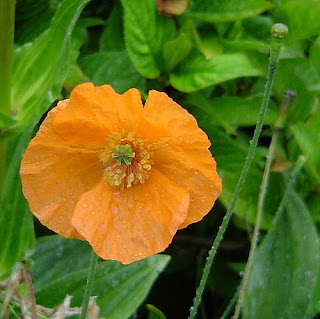 |
| Wellington's superb art deco war memorial in Buckle Street. The tomb of an unknown soldier is here. |
So what are they
like, these ANZAC Day poppies? Of course they're symbolic, not intended to be botanically correct, but how well do they do from a botanist's point of view?
The first ANZAC
Day poppies I remember were from the late 50s or early 60s. There were two kinds. Either you could get a nice fabric 3D poppy
for your donation, or you could get a slip of paper with a picture of a poppy
printed on it. The 3D poppies were
interesting, because, although they were the right shade of red, they didn't
look a lot like a real poppy.
Rather, they were more like a Californian poppy (Eschscholzia
californica) in shape, with a conical corolla.
.jpg) |
| Californian poppy, Eschscholzia californica, Central Otago, New Zealand. |
Later (maybe in the 1980s or 90s) they
changed the design, to this:
In many ways, this
is a more realistic poppy. It has
opposite petals and a dark black spot in the centre of
the flower. But, when you look at
a real poppy it's not really like that.
.jpg) |
| Papaver rhoeas, Sete, southern France. |
First, there are
four petals, not two. Four is an unusual number of petals in flowers. Monocots usually have three or six, and
Eudicots mostly five. Some
Lamiales have four, mostly it seems because two of the five petals have fused
together, as in Veronica. The evidence for that interpretation is in the two sets of
vascular bundles that supply the enlarged posterior petal and the quite common
occurrence of a divided petal (strictly speaking, in families that have the
petals united at their bases into a tube, each is called a corolla lobe rather
than a petal). A few families are characterized by truly having four separate petals, e.g.,
Onagraceae (evening primroses, Fuchsia, etc) and
Brassicaceae (the mustard family).
And of course the poppies and their relatives mostly have four
petals.
Poppy flowers are
interpreted as having two whorls of two petals, rather than one whorl of four
like Brassicaceae. This is because
(1) the outer pair overlaps the inner pair, (2) the calyx has just two opposite
sepals and development of calyx and corolla are often related, and (3) in a few
poppies, like P. bracteatum, there has been a
duplication of a whorl to give 6, not 8, petals. [Note added later: Point 3 isn't well argued, because those poppies have two whorls of three petals, not three whorls of two. So rather than have a whorl duplicated, each of the two whorls has increased the number of its parts from 2 to 3. However, if it had been a single whorl of four petals, such an increase would give five (i.e., 4+1) rather than 6 (i.e., 2x(2+1))]. So the ANZAC poppy is botanically correct in having a pair of opposite
petals, but wrong to have just one pair.
 |
| Long-headed poppy, Papaver dubium, Roca Grosso, Catalonia. |
Sepals fall early
in poppies, as the flower opens (in Californian poppies they’re joined as a cap
that pops off the opening flower), so you wouldn't put sepals on an ANZAC poppy.
The black spot in
a poppy isn’t in the centre of the flower, but there’s one at the base of each
petal. The spot is a variable
feature. Sometimes, especially in cultivated Shirley poppies, it’s absent, or even white.
The makers of ANZAC poppies have used the black dot as a constructed
feature that holds the corolla onto the pedicel (stalk) of the flower, but they
would have done better by making it green to represent the ovary and
stigma. In the true poppies (Papaver), the stigma is a large flat or conical disk on top of the ovary,
and the receptive surfaces (where the pollen adheres) radiate out like the
spokes of a wheel.
In flowers, the
stamens are found between the petals and the ovaries, and in poppies there are
a large number of them. The stamen filaments are black, so they do add to the central black area. Multiple stamens are
hard to represent in a fake flower that has to be cheap, but a tuft of dark
plastic strands would do the job.
Poppy flowers are
fragile, and the petals and stamens soon fall. They can be made to last a day or two in a vase if you pick
them as buds before the stalk straightens (below on the left hand side) and singe the cut ends of the stalks (the milky latex sizzles and
maybe it seals the vascular bundle although I don’t know why that would make
the poppy last longer). Later, the
ovary swells and becomes the seed capsule. Tiny pores open in a ring below the lobes of the stigma, and
the seeds are shaken out through these.
 |
| Corn poppy, Papaver rhoeas, Kaikoura, New Zealand. |
The poppy day
poppy is modeled on the corn poppy, Papaver rhoeas, but other poppies are very similar. In New Zealand the long-headed poppy, P. dubium, is quite common, along with a couple of other similar red-flowered species. Iceland poppies have a
range of flower colours. These are
all annual poppies, but there are perennials too, like the oriental poppies P.
orientale and P. bracteatum and the orange-flowered P. atlanticum.
 |
| Papaver atlanticum, Dunedin Botanic Gardens, New Zealand. |
Another poppy has
a longer association with warfare.
The opium poppy (Papaver somniferum) is
the only natural source of morphine, used for thousands of years as a pain
killer. All poppies have related alkaloid compounds. Most of these are very unpleasant and dangerous
poisons, but thebaine and codeine are used in medicine.
 |
| Opium poppies, Wiltshire, England. |

No comments:
Post a Comment